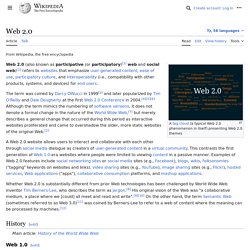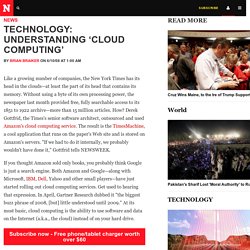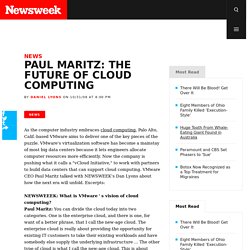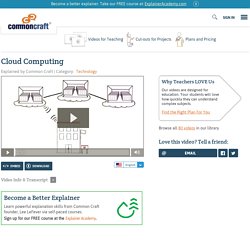Zoom
Trash

IIS Windows Server. Web 2.0 in Education. Latest app reviews. Web 2.0. World Wide Web sites that use technology beyond the static pages of earlier Web sites A tag cloud (a typical Web 2.0 phenomenon in itself) presenting Web 2.0 themes Web 2.0 (also known as Participative (or Participatory)[1] and Social Web)[2] refers to websites that emphasize user-generated content, ease of use, participatory culture and interoperability (i.e., compatible with other products, systems, and devices) for end users.

The term was invented by Darcy DiNucci in 1999 and later popularized by Tim O'Reilly and Dale Dougherty at the O'Reilly Media Web 2.0 Conference in late 2004.[3][4][5][6] The Web 2.0 framework specifies only the design and use of websites and does not place any technical demands or specifications on designers. The transition was gradual and, therefore, no precise date for when this change happened has been given. [which?] History[edit] Technology: Understanding ‘Cloud Computing’ Like a growing number of companies, the New York Times has its head in the clouds—at least the part of its head that contains its memory.

Without using a byte of its own processing power, the newspaper last month provided free, fully searchable access to its 1851 to 1922 archive—more than 15 million articles. How? Derek Gottfrid, the Times's senior software architect, outsourced and used Amazon’s cloud computing service. The result is the TimesMachine, a cool application that runs on the paper's Web site and is stored on Amazon's servers. "If we had to do it internally, we probably wouldn't have done it," Gottfrid tells NEWSWEEK. If you thought Amazon sold only books, you probably think Google is just a search engine. Subscribe now - Free phone/tablet charger worth over $60 Ten years ago if you wanted to do something with your PC you needed to buy software and install it.
Paul Maritz: The Future of Cloud Computing. As the computer industry embraces cloud computing, Palo Alto, Calif.

-based VMware aims to deliver one of the key pieces of the puzzle. VMware's virtualization software has become a mainstay of most big data centers because it lets engineers allocate computer resources more efficiently. Now the company is pushing what it calls a "vCloud Initiative," to work with partners to build data centers that can support cloud computing. Cloud computing. Cloud computing metaphor: For a user, the network elements representing the provider-rendered services are invisible, as if obscured by a cloud.

Cloud computing is a computing term or metaphor that evolved in the late 1990s, based on utility and consumption of computer resources. Cloud computing involves application systems which are executed within the cloud and operated through internet enabled devices. Purely cloud computing does not rely on the use of cloud storage as it will be removed upon users download action. Clouds can be classified as public, private and hybrid.[1][2] Overview[edit] Cloud computing[3] relies on sharing of resources to achieve coherence and economies of scale, similar to a utility (like the electricity grid) over a network.[2] At the foundation of cloud computing is the broader concept of converged infrastructure and shared services. Cloud computing, or in simpler shorthand just "the cloud", also focuses on maximizing the effectiveness of the shared resources. CloudTrip - Your Source for Web Applications. ExplainingComputers.com: Web 2.0.
Web 2.0 For a list of Web 2.0 (SaaS) applications, please see the Cloud Computing Directory "Web 2.0" refers to the use of the Internet for interpersonal content sharing and online service delivery.

Whereas the unnamed "Web 1.0" that came before it was largely concerned with creating and viewing online content (reflected in the browser wars and in a proliferation of websites that few people ever visited), the Web 2.0 concept highlights services that allow people to find and manipulate content, coupled with those that enable all types of media and services to be published and interlinked (or "mashed") in places that lots of people actually know about. Twitter Explained by Common Craft. So, what are you doing?

It's one of the first questions we often ask friends and family. Even if the answer is just mowing the lawn or cooking dinner, it's interesting to us. It makes us feel connected and a part of each other's lives. Unfortunately, most of our day-to-day lives are hidden from people that care. Booooo! Social Networking Explained by Common Craft. Networks get things done.

Whether it's sending a letter or lighting your home. Networks make it happen. To get from Chicago to Santa Fe, we need to see the network of roads that will get us there. We see that Chicago is connected to St Louis, which is connected to Dallas, which is connected to Santa Fe. Of course, people networks can help us with finding jobs, meeting new friends, and finding partners. The problem with social networks in the real world is that most of the connections between people are hidden. Social Media Explained by Common Craft. I’m sure you’ve heard the buzz.

Social Media may be the next big thing. What’s it all about? Let’s take a visit to Scoopville, a town that’s famous for ice cream. For over 20 years, Big Ice Cream Company has been making high quality ice cream with a big factory in town. A few years back, the company did focus groups and found out that they could maximize profits by offering three flavors: Chocolate, Vanilla and Strawberry. The residents of the town were content. The Smiths decided to make pineapple ice cream. RSS Explained by Common Craft. The Internet has problems.

Cloud Computing Explained by Common Craft. Computers used to work alone, inside a home or business.

But thanks to the Internet, we can now use the power of computers at a completely different location - what we call "in the cloud". To start, meet Lucy from Lucy's Lilies, a new florist. Social Bookmarking Explained by Common Craft. It's just too much. Did you know that there are over 15 billion web pages? To make sense of it all, we need to pluck out the best pages and save them for later.
Online Photo Sharing Explained by Common Craft. When asked what should be saved in a fire, along with family and pets, people often choose photos. If photos mean a lot to you, it's time to learn why keeping them on the web makes sense. As you know, cameras and photography have changed. What used to appear on paper, now appears on computers and phones. No matter the format, we still love our photos and now they they have new powers. Podcasting Explained by Common Craft.
Remember the good old days of TV and radio? Everyone would gather around to be entertained. Wikis Explained by Common Craft. These four friends are going on a camping trip. They need to bring the right supplies because they're backpacking. The group needs to plan and plan well, so coordination is key. Blogs Explained by Common Craft. You've seen the word, you've seen the web sites and you may even have one.
But have you ever wondered: What's the big deal about blogs? To make sense of blogs, you have to think about the news and who makes it. We'll look at news in the 20th vs. the 21st century to make our point. In the 20th century, the news was produced professionally. When news happened, reporters wrote the stories and a tiny group of people decided what appeared in a newspaper or broadcast. The 21st century marked the point where news became both professional and personal. As blogs became popular, they created millions of news sources and gave everyone an audience for their own version of news.
With a blog...A business owner can share news about his business A mother can share news about her family Or a sport star can share news with fans These people are all "bloggers". Web 2.0. The Machine is Us/ing Us (Final Version) Common Craft. Cloud Computing Explained by Common Craft. Explaining Cloud Computing. ExplainingComputers.com: Cloud Computing. Cloud Computing Cloud computing is where software applications, processing power, data and artificial intelligence are accessed over the Internet. Many private individuals now regularly use an online e-mail application such as Gmail, as well as sharing photos and video on social networking sites like Facebook.
However, these types of cloud computing activities are just the beginning. Indeed, it is likely that within a decade the vast majority of personal and business computing will be Internet based. According to IDC, cloud computing was a $47.4bn industry in 2013, and will be worth $107bn by 2017 (IDC).